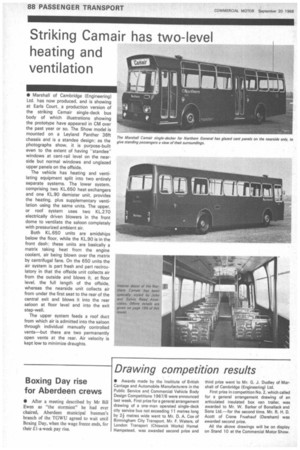Striking Camair has two-leve heating and ventilation
Page 92

If you've noticed an error in this article please click here to report it so we can fix it.
• Marshall of Cambridge (Engineering) Ltd. has now produced, and is showing at Earls Court, a production version of the striking Camair single-deck bus body of which illustrations showing the prototype have appeared in CM over the past year or so. The Show model is mounted on a Leyland Panther 36ft chassis and is a standee design; as the photographs show, it is purpose-built even to the extent of having "standee windows at cant-rail level on the nearside but normal windows and unglazed upper panels on the offside.
The vehicle has heating and ventilating equipment split into two entirely separate systems. The lower system, comprising two KL650 heat exchangers and one KL.90 demister unit, provides the heating, plus supplementary ventilation using the same units. The upper, or roof system uses two KL.270 electrically driven blowers in the front dome to ventilate the saloon completely with pressurized ambient air.
Both KL.650 units are amidships below the floor, while the KL.90 is in the front dash; these units are basically a matrix taking heat from the engine coolant, air being blown over the matrix by centrifugal fans. On the 650 units the air system is part fresh and part recirculatory in that the offside unit collects air from the outside and blows it, at floor level, the full length of the offside, whereas the nearside unit collects air from under the first seat to the rear of the central exit and blows it into the rear saloon at floor level and into the exit step-well.
The upper system feeds a roof duct from which air is admitted into the saloon through individual manually controlled vents—but there are two permanently open vents at the rear. Air velocity is kept low to minimize draughts.


















































































































































































































































































































































































